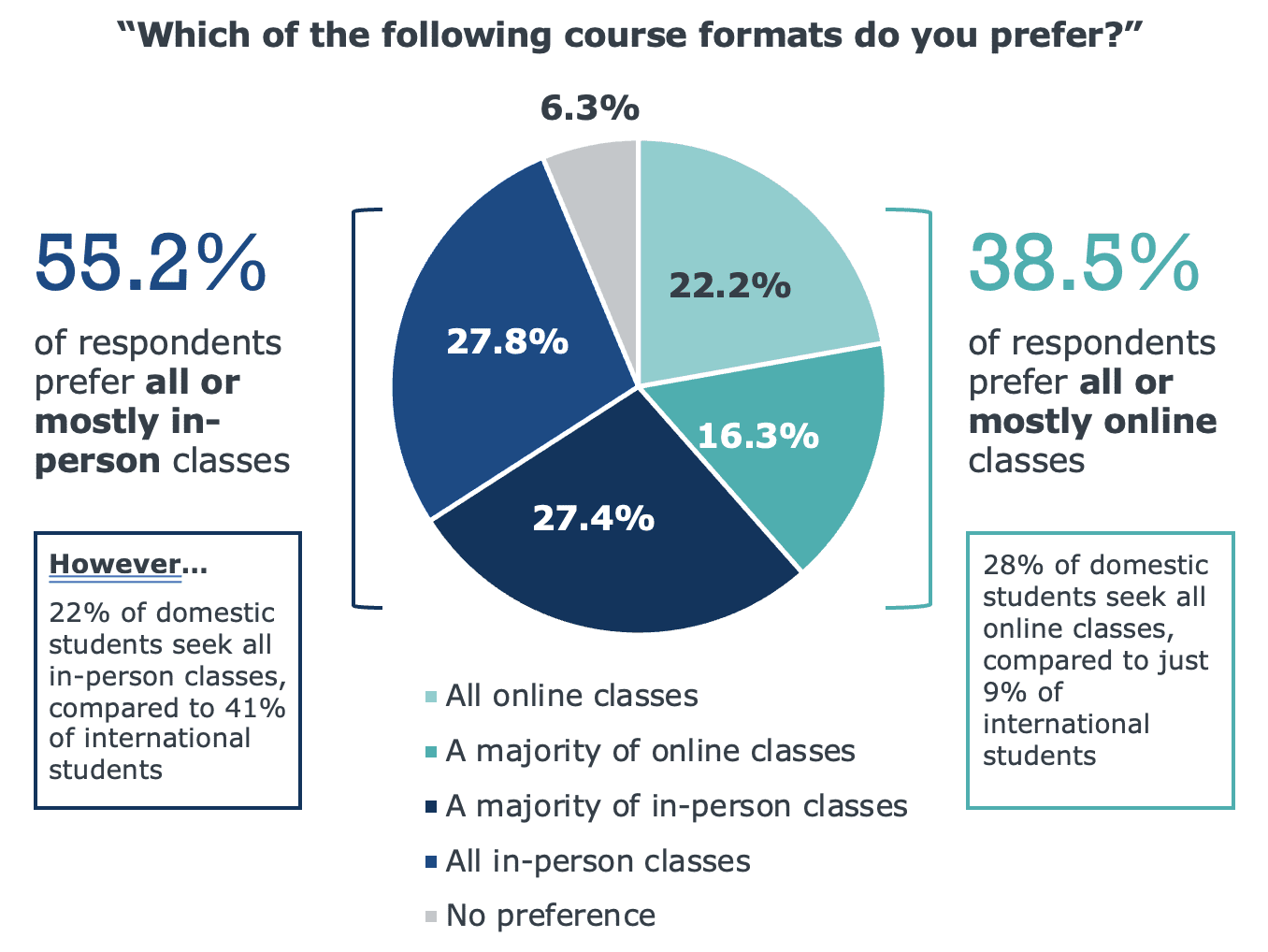We asked 3,800+ graduate and adult students about their program preferences. Here’s what they shared.
Insights from EAB's new survey of 3,800 graduate and adult learners
October 3, 2023, By Tess Arena, Director, Product Marketing
Earlier this year, our Adult Learner Recruitment team surveyed more than 3,800 current and prospective graduate students and adult learners to learn more about their motivations and expectations when evaluating program options. Some of our most interesting—and surprising—findings came when we asked students about their interest in online programming, schedule preferences, and willingness to consider alternative credentials. Read on to see what your current and future adult learners shared about these topics.
Download the Full Survey Findings
Student interest in online programs varies significantly by segment
During the earlier part of COVID-19, we saw an extreme shift toward online as institutions were forced to move programming online. This trend has stabilized late in the pandemic. As you may be seeing firsthand on your campus, online graduate enrollments nationwide are now almost even with face-to-face graduate enrollments. In 2021, IPEDS distance enrollment data indicates there were 1.3 million online graduate enrollments, compared to 1.4 million face-to-face graduate enrollments nationwide.
Hear EAB’s latest research on the state of online enrollment
The students we surveyed expressed mixed interest in online courses. Fifty-five percent of respondents said they prefer all or mostly in-person classes. However, this number is likely inflated by the percentage of international students who responded to our survey (21%). Only 22% of surveyed domestic students seek all in-person classes, compared to 41% of international students.

About 39% of the students we surveyed said they prefer all or mostly online classes—although again, this number is deflated by the 9% of international students who prefer online options. In addition to domestic students, prospective adult degree completers, students over age 36, women, caregivers, and students who work full-time disproportionately prefer online courses when compared to their peers (consistent with findings from our past surveys).
The top 5 ways adult learners are finding your programs
More than 40% of students want both asynchronous and synchronous online courses
Perhaps one of the most common questions our EAB program design experts field is: “Should we offer online courses asynchronously or synchronously?” While the answer will vary by program type, resources, and the like, it’s noteworthy that 42% of survey respondents prefer a mix of asynchronous and synchronous courses.

Students express interest in weekday, daytime classes
We also asked students to share their preference for class schedules. More than half of respondents (56%) prefer all weekday classes. While students across all student segments most often indicated preference for all weekday classes, students under age 26, those who are not currently employed, and prospects interested in legal education disproportionately prefer all weekday courses. When asked about ideal time of day for class, 37% said they favor all daytime classes. However, students over age 36 indicate a slight preference for all evening courses, as do students interested primarily in online programs.
Respondents share mixed interest in certificates and microcredentials
Finally, given ongoing discussion about different credential types—think certificates, microcredentials, and badges—we asked prospective master’s students about their interest in pursuing one of these credentials instead of a master’s degree. About 29% of respondents said they are “extremely likely” or “very likely” to pursue a different credential in lieu of a master’s. However, 36% said they are “somewhat unlikely” or “not likely at all” to consider a certificate, microcredential, or other offering. Students 26 to 35 and those interested in business programs are among the prospects most likely to express interest in a different credential.
Thinking of launching a certificate program? Avoid these mistakes.
New research from our Professional and Adult Education Advisory Services identifies a few barriers to growing microcredential programs:
- Low student awareness: Many students are not familiar with digital credential programs—and even those aware of these offerings often don’t know where to start.
- Minimal employer uptake: Employers consistently say that they think microcredentials are a good idea. But when our team looked further into SHRM data, we found that HR staff (those who likely do initial candidate screenings) don’t value microcredentials as much as executives and supervisors. Our researchers also identified HR software as a barrier—some resume scanning software is unable to identify alternative credentials, meaning students with these credentials may be overlooked.
- Institution resistance to microcredentials (whether implicit or explicit): New program types like microcredentials require revising academic policies and processes. And for microcredentials, institutions often need to acquire new tech platforms (like badging software) and consider ways to help students fund these programs (since microcredentials are generally ineligible for federal financial aid).
Our researchers are continuing to track student awareness of and employer perception of microcredentials—stay tuned.
Interested in more on microcredentials? Subscribe to our blog.
These findings just scrape the surface of the insights from our survey. To learn more about how students are making enrollment decisions, check out our full insight paper.

More Blogs

What it takes to win in grad and adult enrollment today

Our new staffing model playbook for higher ed CMOs
